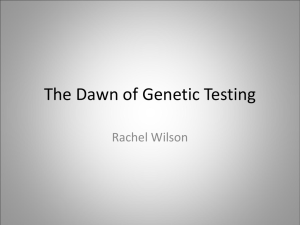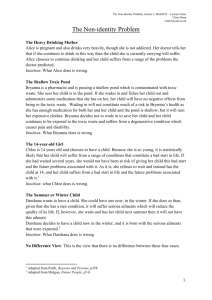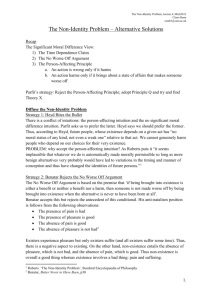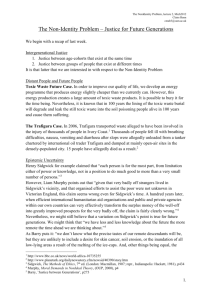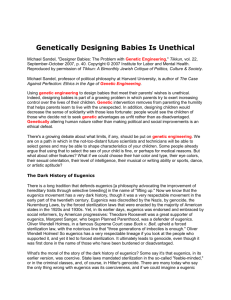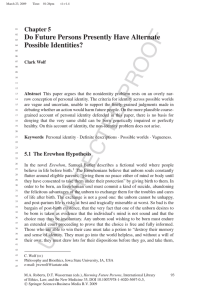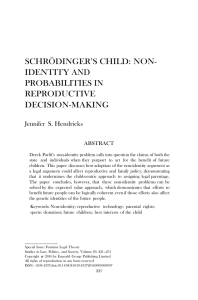The NonIdentity Problem Lecture Notes
advertisement
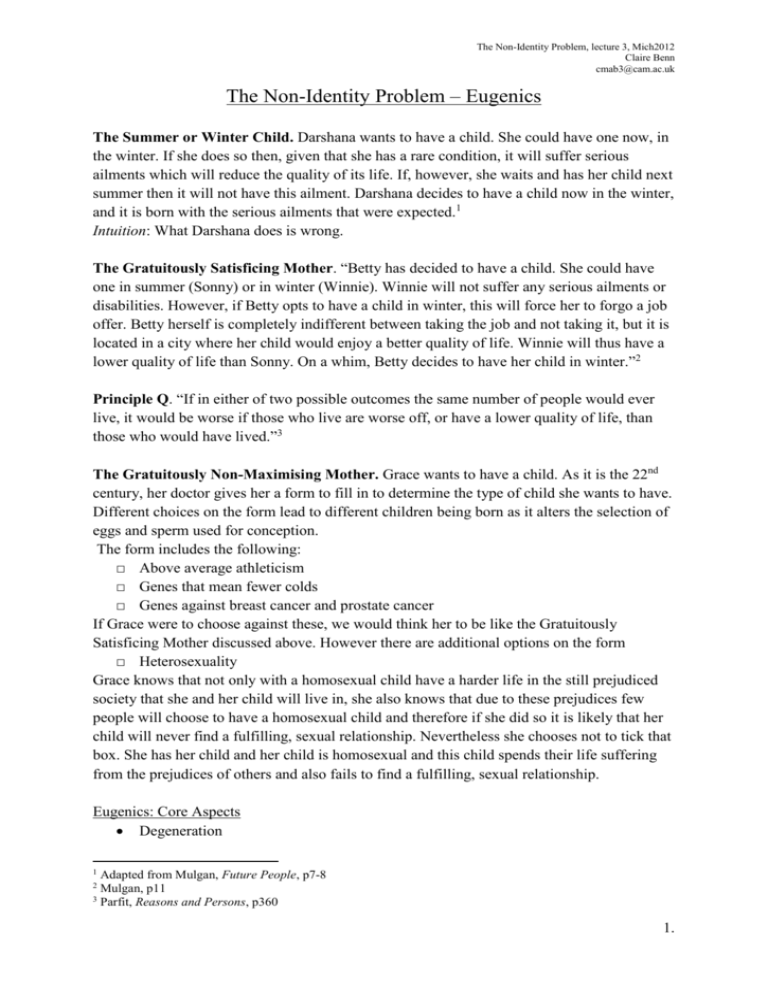
The Non-Identity Problem, lecture 3, Mich2012 Claire Benn cmab3@cam.ac.uk The Non-Identity Problem – Eugenics The Summer or Winter Child. Darshana wants to have a child. She could have one now, in the winter. If she does so then, given that she has a rare condition, it will suffer serious ailments which will reduce the quality of its life. If, however, she waits and has her child next summer then it will not have this ailment. Darshana decides to have a child now in the winter, and it is born with the serious ailments that were expected.1 Intuition: What Darshana does is wrong. The Gratuitously Satisficing Mother. “Betty has decided to have a child. She could have one in summer (Sonny) or in winter (Winnie). Winnie will not suffer any serious ailments or disabilities. However, if Betty opts to have a child in winter, this will force her to forgo a job offer. Betty herself is completely indifferent between taking the job and not taking it, but it is located in a city where her child would enjoy a better quality of life. Winnie will thus have a lower quality of life than Sonny. On a whim, Betty decides to have her child in winter.”2 Principle Q. “If in either of two possible outcomes the same number of people would ever live, it would be worse if those who live are worse off, or have a lower quality of life, than those who would have lived.”3 The Gratuitously Non-Maximising Mother. Grace wants to have a child. As it is the 22nd century, her doctor gives her a form to fill in to determine the type of child she wants to have. Different choices on the form lead to different children being born as it alters the selection of eggs and sperm used for conception. The form includes the following: □ Above average athleticism □ Genes that mean fewer colds □ Genes against breast cancer and prostate cancer If Grace were to choose against these, we would think her to be like the Gratuitously Satisficing Mother discussed above. However there are additional options on the form □ Heterosexuality Grace knows that not only with a homosexual child have a harder life in the still prejudiced society that she and her child will live in, she also knows that due to these prejudices few people will choose to have a homosexual child and therefore if she did so it is likely that her child will never find a fulfilling, sexual relationship. Nevertheless she chooses not to tick that box. She has her child and her child is homosexual and this child spends their life suffering from the prejudices of others and also fails to find a fulfilling, sexual relationship. Eugenics: Core Aspects Degeneration 1 Adapted from Mulgan, Future People, p7-8 Mulgan, p11 3 Parfit, Reasons and Persons, p360 2 1. The Non-Identity Problem, lecture 3, Mich2012 Claire Benn cmab3@cam.ac.uk Heritability of traits Core Aim of Eugenicists: “concern for human betterment through selection – that is, by taking measures to ensure that the humans who do come into existence will be capable of enjoying better lives and of contributing to the betterment of lives of others.”4 Eugenics and the Non-Identity Problem Degeneration → Concern with well-being Heritability → Concern with identity The Medical Programmes. “There are two rare conditions, J and K, which cannot be detected without special tests. If a pregnant woman has Condition J, this will cause the child she is carrying to have a certain handicap. A simple treatment would prevent this effect. If a woman has Condition K when she conceives a child, this will cause this child to have the same particular handicap. Condition K cannot be treated, but always disappears within two months. Suppose next that we have planned two medical programmes, but there are funds for only one; so one must be cancelled. In the first programme, millions of women would be tested during pregnancy. Those found to have Condition J would be treated. In the second programme, millions of women would be tested when they intend to try to become pregnant. Those found to have Condition K would be warned to postpone conception for at least two months, after which this incurable condition will have disappeared. Suppose finally that we can predict that these two programmes would achieve results in as many cases. If there is Pregnancy Testing, 1,000 children a year will be born normal rather than handicapped. If there is Preconception Testing, there will each year be born 1,000 normal children rather than a 1,000, different, handicapped children.”5 Public Policy and Reproductive Freedom The Blood Test. “A single, inexpensive blood test for prospective parents can detect high risk for virtually all serious genetic disorders as well as a broad range of genetic susceptibilities for illnesses. An initiative is afoot to provide mass genetic screening using this test. A government commission examining the feasibility of this proposal notes that the program’s cost-effectiveness depends on whether a sufficient number of those tested “act on the knowledge of positive results – that is, whether they choose to avoid conception of affected foetuses.” An advocate of the mass screening program says “this is a public health matter; people should not be free to inflict avoidable diseases on their children, especially if we are ever to have an affordable health care system that provides coverage for everyone.” An opponent replies that “genetic services of any kind are strictly a matter of personal choice – respect for reproductive freedom requires this. People must be free to act on the test results as they see fit; any program that will result in pressures that limit reproductive freedom would be unacceptable.””6 4 Buchanan, p42 Parfit, p367 6 Buchanan et al., From Chance to Choice, p2 5 2. The Non-Identity Problem, lecture 3, Mich2012 Claire Benn cmab3@cam.ac.uk The Vertical Epidemic Model: “While persons infected with cholera were a menace to those with whom they came into contact, individuals with defective [genes] were an even greater threat to society: They transmitted harm to an unlimited line of persons across many generations. The only difference between the ‘horizontally transmitted’ infectious diseases and ‘vertically transmitted’ genetic diseases, according to this view, was that the potential harm caused to the latter was even greater. So if measures such as quarantine and restrictions on travel into disease areas that infringed individual freedom were appropriate responses to the former, then they were even more readily justified to avert the greater potential harm of the latter. This variant of the public health model may be called the vertical epidemic model.”7 Consequentialism and Reproductive Freedom “Suppose an affluent person in the developed world (call her ‘Affluent’) must choose between the following three projects. The Reproduction Project. Affluent has a child of her own, and then allocates a substantial amount of her income to the project of raising that child. The Adoption Project. Affluent adopts an already existing child, and then allocates a substantial amount of her income to the project of raising that child. The Oxfam Project. Affluent has no children, and donates a substantial amount of her income to charity. Other things equal, most people believe that Affluent is morally permitted to pursue any of the three projects.”8 The Basic Liberty Intuition. “People should be able to decide for themselves whether or not, and in what way, to reproduce.”9 Compulsory No Reproduction Could we do more good if we didn’t have a child but (a) took care of our existing children or (b) gave our money to charity instead. Compulsory Reproduction Impersonal Total Principle: We are required to have children who have lives where their happiness outweighs the negative effect on others and the unhappiness in their own lives. Impersonal Average Principle: We are required to have children if their existence will raise the average well-being. Hell Three. “Most of us have lives that are much worse than nothing. The exceptions are the sadistic tyrants who make us suffer. The rest of us would kill ourselves if we could; but this is 7 Buchanan et al., From Chance to Choice, p12 Mulgan, p6 9 Mulgan, Future People, p6 8 3. The Non-Identity Problem, lecture 3, Mich2012 Claire Benn cmab3@cam.ac.uk made impossible. The tyrants claim truly that, if we have children, they will make these children suffer slightly less.”10 Demandingness Requires too great a sacrifice in well-being (See Singer’s Pretty Demanding Dictate: On pain of living a life that’s seriously immoral, a typical well-off person, like you and me, must give away most of her financially valuable assets, and much of her income.) Leaves no ‘optional’ actions (where they are neither required nor forbidden) The Pursuit of Perfection The Perfect Baby. “Except from the introduction to a dissertation in a history of medicine written in 2040: In the 1990s, as in the preceding three decades, parents mainly practiced negative eugenics, using tests for major chromosomal defects such as Down syndrome and aborting ‘defective’ foetuses. By 2020 the standards for acceptable babies had been raised: prospective parents routinely aborted foetuses that were otherwise healthy but that had genes that gave them a significantly higher than average risk of breast cancer, colorectal cancer, Alzheimer’s dementia, or coronary artery disease. By 2030, the trend was toward even high standards: Foetuses with any of a range of ;undesirable’ or ‘less than optimal’ combinations of genes were routinely aborted, including those predicted not to be in the highest quintile with respect to intelligence or even height. Widespread use of these techniques by parents who could afford them began to raise the average level of health, physical strength and stature, and intellectual ability in the population, a trend encouraged by nationalistic politicians. But the insistence of many parents that their child be in the upper quintile created a spiral in which no amount of genetic boost ever seemed enough.”11 Consequentialism fails to have what most people use to try and save eugenics: a distinction between: (a) Negative genetic engineering/eugenics: the elimination of defects (b) Positive genetic engineering/eugenics: the pursuit of perfection Can’t distinguish between these types of cases Prevention of Lives and the Prevention of Disease Also can’t distinguish between the prevention of disease and prevention of lives: to conflate these “is to traduce completely the meaning of preventative medicine. It would lead to the grotesque claim that the National Socialists did more to ‘prevent’ future generations of TaySachs [a lethal genetic disease found most commonly among Jews] sufferers than all the efforts of science to date. Genetic counselling and selective abortion are substitutes for disease prevention and cure.”12 10 Parfit, Reasons and Persons, p422 Buchanan et al., From Chance to Choice, p2-3 12 Buchanan, p46, from Lewontin, 1997, italics in original 11 4.

